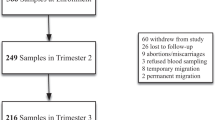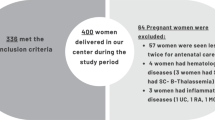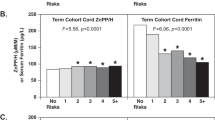Abstract
Objective:
The purpose of this study was to assess the prevalence of iron deficiency anemia among Korean pregnant women and to assess the association between maternal hemoglobin (Hb) level and pregnancy outcome.
Design:
A longitudinal study.
Setting:
Ewha Womans University Hospital, Seoul, Korea.
Subjects:
A total of 248 normal pregnant women of 24–28 weeks gestation and 190 babies born to the pregnant subjects.
Methods:
Maternal anthropometry, blood parameters and pregnancy outcomes were measured.
Results:
Mean Hb, serum iron concentration, transferrin saturation and total iron binding capacity of the subjects were 11.4 g/dl, 89.4 μg/dl, 18.7% and 484.6 μg/dl, respectively, and 30.2% of the subjects were anemic judged by Hb concentration of <10.5g/dl. When subjects were classified into tertile groups based on Hb levels, the lowest tertile (HbT1) group had significantly lower concentrations of cord serum iron and albumin than those in the highest tertile (HbT3) group. Newborn infants from the HbT1 group had significantly higher rates of preterm delivery, low birth weight and low Apgar scores than those in other groups. Logistic regression analysis showed that maternal serum albumin and Hb level were the most important predictive variables for low birth weight.
Conclusions:
A substantial proportion of Korean pregnant women were at risk of anemia. Infants born to women with a low Hb level showed a lower birth weight, height and Apgar scores.
Sponsorship:
This study was supported by a grant from the Korea Health 21 R&D project, Ministry of Health and Welfare, Republic of Korea (no. 01-PJ1-PG1-01CH15-0009).
This is a preview of subscription content, access via your institution
Access options
Subscribe to this journal
Receive 12 print issues and online access
$259.00 per year
only $21.58 per issue
Buy this article
- Purchase on Springer Link
- Instant access to full article PDF
Prices may be subject to local taxes which are calculated during checkout
Similar content being viewed by others
References
Allen LH (2000). Anemia and iron deficiency: effects on pregnancy outcome. Am J Clin Nutr 71, S1280–S1284.
Allen LH (2001). Biological mechanisms that might underlie iron's effects on fetal growth and preterm birth. J Nutr 131, S581–S589.
Apgar V (1953). A proposal for a new method of evaluating of the newborn infant. Curr Res Anesth Analg 32, 260–267.
Centers for Disease Control (CDC) (1990). Anemia during pregnancy in low-income women – United States, 1987. Morb Mortal Wkly Rep 39, 73–76.
Cogswell ME, Parvanta I, Ickes L, Yip R, Brittenham GM (2003). Iron supplementation during pregnancy, anemia, and birth weight: a randomized controlled trial. Am J Clin Nutr 78, 773–781.
DeMaeyer E, Adiels-Tegman M (1985). The prevalence of anaemia in the world. World Health Stat Quart 38, 302–316.
Doo MA (2004). Nutritional risk factor and iron supplementation effect for unwed pregnant women. Master Thesis, Ewha Womans University, Seoul.
Guyer B, Martin JA, MacDorman MF, Anderson RN, Strobino DM (1997). Annual summary of vital statistics – 1996. Pediatrics 100, 905–918.
Haas JD, Brownlie 4th T (2001). Iron deficiency and reduced work capacity: a critical review of the research to determine a causal relationship. J Nutr 131, S676–S688.
Herbert V (1987). The 1986 Herman Award Lecture. Nutrition science as a continually unfolding story: the folate and vitamin B-12 paradigm. Am J Clin Nutr 46, 387–402.
Hui J, Qing H, Changan L, Li L, Yongzheng M, Qiao Z (1995). The investigation of iron deficiency among pregnant women. Acta Acad Med Sian 16, 437–439.
Kaiser LL, Allen LH (2002). Position of the American dietetic association: nutrition and lifestyle for a healthy pregnancy outcome. J Am Diet Assoc 102, 1479–1490.
Kim EK, Lee KH (1999). Iron status in pregnant women and their newborn infants. Korean J Nutr 32, 793–801.
King JC (2000). Determinants of maternal zinc status during pregnancy. Am J Clin Nutr 71, S1334–S1343.
Korean Ministry of Health and Welfare (2002). Report of 2001 National Health and Nutrition Survey.
Krafft A, Huch R, Breymann C (2003). Impact of parturition on iron status in nonanaemic iron deficiency. Eur J Clin Invest 33, 919–923.
Lee EJ, Kim MH, Cho MS, Kim YJ, Kim WY (2003). A study on nutrition intakes and hematological status in women of child-bearing age: comparison between non-pregnant and pregnant women. Korean J Nutr 36, 191–199.
Lim HS, Kim HA (1998). Effects of maternal anemia on the iron status of the cord blood and pregnancy outcomes. Korean J Commun Nutr 3, 565–573.
Lone FW, Qureshi R, Emanuel F (2004). Maternal anemia and its impact on perinatal outcome. Trop Med Int Health 9, 486–490.
Lu ZM, Goldenberg RL, Cliver SP, Cutter G, Blankson M (1991). The relationship between maternal hematocrit and pregnancy outcome. Obstet Gynecol 77, 190–193.
Madhavan Nair K, Bhaskaran P, Balakrishna N, Ravinder P, Sesikeran B (2004). Response of hemoglobin, serum ferrtin, and serum transferring: a prospective study. Nutrition 20, 896–899.
Murphy JF, O'Riordan J, Newcombe RJ, Coles EC, Pearson JF (1986). Relation of hemoglobin levels in first and second trimesters to outcome of pregnancy. Lancet 1, 992–995.
Nilman N, Pedersen AN, Ovesen L, Schroll M (2004). Iron status in 358 apparently healthy 80-year-old Danish men and women: relation to food consumption and dietary and supplemented iron intake. Ann Hematol 83, 423–429.
Prema K (1980). Predictive value of serum copper and zinc in normal and abnormal pregnancy. Indian J Med Res 71, 554–560.
Ramakrishnan U, Yip R (2002). Experiences and challenges in industrialized countries: control of iron deficiency in industrialized countries. J Nutr 132, S820–S824.
Rasmussen KM (2001). Is there a causal relationship between iron deficiency or iron deficiency anemia and weight at birth, length of gestation and perinatal mortality? J Nutr 131, S590–S603.
Rush D (2000). Nutrition and maternal mortality in the developing world. Am J Clin Nutr 72 (Suppl), S212–S240.
Scholl TO, Hediger ML (1994). Anemia and iron deficiency anemia: complication of data on pregnancy outcome. Am J Clin Nutr 59, S492–S501.
Scholl TO, Reilly T (2000). Anemia, iron and pregnancy outcome. J Nutr 130, S443–S447.
Seo HJ (2005). The nutritional status, pregnancy outcomes in unwed pregnancy women and the effect of iron supplementation. Master Thesis, Ewha Womans University, Seoul.
Singh K, Fong YF, Arulkumaran S (1998). Anaemia in pregnancy – a cross-sectional study in Singapore. Eur J Clin Nutr 52, 65–70.
Thane CW, Bates CJ, Prentice A (2003). Risk factors for low iron intake and poor iron status in a national sample of British young people aged 4–18 years. Public Health Nutr 6, 485–496.
Yip R (2000). Significance of an abnormally low or high hemoglobin concentration during pregnancy: special consideration of iron nutrition. Am J Clin Nutr 72, S272–S279.
Yu KH, Yoon JS, Hahm YS (1999). A cross-sectional study of biochemical analysis and assessment of iron deficiency by gestational age (II). Korean J Nutr 32, 887–896.
Zhou LM, Yang WW, Hua JZ, Deng CQ, Tao X, Stoltzfus RJ (1998). Relation of hemoglobin measured at different times in pregnancy to preterm birth and low birth weight in Shanghai, China. Am J Epidemiol 148, 998–1006.
Zimmermann MB, Chaouki N, Hurrell RF (2005). Iron deficiency due to consumption of a habitual diet low in bioavailable iron: a longitudinal cohort study in Moroccan children. Am J Clin Nutr 81, 115–121.
Author information
Authors and Affiliations
Corresponding author
Additional information
Guarantor: HS Lee, WY Kim.Contributor: HSL and WYK contributed to the design of the study, subject recruiting and manuscript preparation. MSK and MHK carried out the data analysis and biochemical analyses. YJK was responsible for clinical data collection. WYK was mainly responsible for all stages of the study. All took part in writing this paper.
Rights and permissions
About this article
Cite this article
Lee, H., Kim, M., Kim, M. et al. Iron status and its association with pregnancy outcome in Korean pregnant women. Eur J Clin Nutr 60, 1130–1135 (2006). https://doi.org/10.1038/sj.ejcn.1602429
Received:
Revised:
Accepted:
Published:
Issue Date:
DOI: https://doi.org/10.1038/sj.ejcn.1602429
Keywords
This article is cited by
-
Adverse effects of iron deficiency anemia on pregnancy outcome and offspring development and intervention of three iron supplements
Scientific Reports (2021)
-
Perinatal Outcomes Among Venezuelan Immigrants in Colombia: A Cross-Sectional Study
Journal of Immigrant and Minority Health (2021)
-
Differentials in the prevalence of anemia among non-pregnant, ever-married women in Bangladesh: multilevel logistic regression analysis of data from the 2011 Bangladesh Demographic and Health Survey
BMC Women's Health (2015)
-
Anemia During Pregnancy after Silastic Ring Roux-en-Y Gastric Bypass: Influence of Time to Conception
Obesity Surgery (2011)
-
HFE Gene Variants Modify the Association between Maternal Lead Burden and Infant Birthweight: A Prospective Birth Cohort Study in Mexico City, Mexico
Environmental Health (2010)



